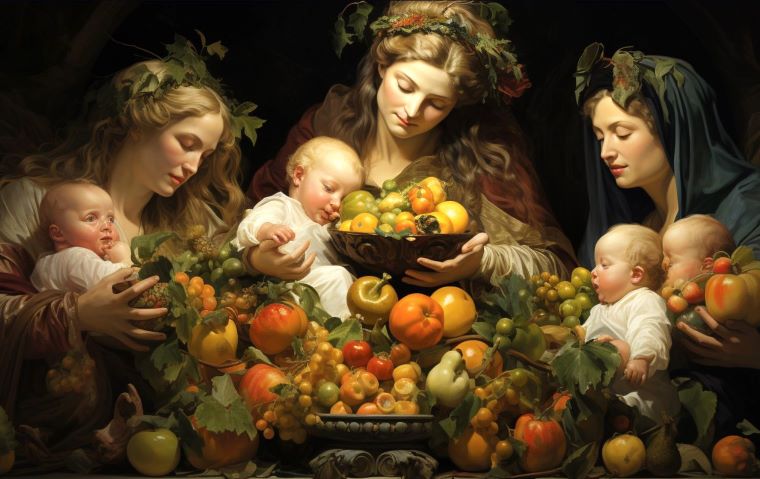
Sirona, the ancient goddess of healing, fertility, and the sun, occupies a unique place in the pantheon of European deities. Her veneration spans across Celtic and Gallo-Roman cultures, where she is revered as a guardian of life’s most essential aspects.
Historical Context
The cult of Sirona, originating in the Celtic heartlands, represents a confluence of indigenous beliefs and Roman religious practices. With the Roman expansion into Celtic territories, the assimilation of local deities into the Roman pantheon facilitated the spread of Sirona’s worship. This syncretism is evident in the dual naming conventions of deities and the shared iconography found in statues and inscriptions. Archaeological discoveries, such as the temple at Hochscheid in Germany, provide tangible evidence of her worship, showcasing inscriptions and artifacts that depict her healing attributes.
Iconography and Symbols
Sirona’s iconography is rich with symbols of healing and fertility. She is frequently depicted alongside a snake, a universal symbol of renewal and medicine, reflecting her association with healing powers. The presence of dogs in her imagery, animals connected with protection and loyalty, signifies her role as a protector of health and well-being. Additionally, the depiction of Sirona with eggs and bowls of water emphasizes her influence over fertility and the purifying qualities of water, respectively.
Mythology and Worship of Sirona
Though the mythological narratives of Sirona are not as prolific as those of other Celtic goddesses, her significance is underscored by her association with healing sanctuaries. These sites, often located near thermal springs, were centers of healing rituals and attracted pilgrims from distant lands. The waters of these springs, believed to be blessed by Sirona, were sought for their curative properties. The rituals performed at these sites, including offerings and the immersion in sacred waters, reflect the ancients’ belief in the divine’s power to heal and purify.

Sirona’s Domains
Healing
Sirona’s dominion over healing encompasses both physical and spiritual ailments. The ancient approach to healing was holistic, recognizing the interplay between the body, spirit, and the natural world. Sirona’s sanctuaries served as hubs for this holistic healing, where the sick sought relief through ritualistic practices and the medicinal properties of natural springs. These practices underscore the ancient understanding of health as a balance of forces, with Sirona as a mediator of this balance.
Fertility
The fertility aspect of Sirona’s worship highlights her role in ensuring the continuity of life and the prosperity of communities. Fertility rituals dedicated to Sirona involved the offering of grains and fruits, symbolizing the hope for abundant harvests and healthy offspring. These offerings, often made at her temples or natural springs, signify the link between the divine, the natural world, and human prosperity. Sirona’s role in fertility extends beyond human concerns, embodying the fertility of the earth itself.
The Sun
Sirona’s connection to the sun, while less emphasized, plays a crucial role in her association with life and vitality. The sun’s cycle governs the seasons, agricultural growth, and the rhythm of life itself. By integrating solar symbolism into Sirona’s worship, the ancients acknowledged her influence over the essential elements of life. Seasonal festivals aligned with solar events celebrated the cyclical nature of growth and decay, symbolizing Sirona’s role in the renewal of life.
Sirona in Modern Times
The revival of interest in Sirona among neopagans and modern spiritual practitioners underscores the timeless appeal of her domains. In contemporary rituals, she is invoked for her healing and nurturing powers, reflecting a modern desire to connect with ancient wisdom and the natural world. This resurgence of interest speaks to the universal themes of health, fertility, and the cyclical nature of life, which Sirona embodies.
Comparative Mythology
A comparative analysis reveals Sirona’s counterparts in various mythologies, such as Brigid in Irish mythology and Apollo in Greek mythology. These deities share common themes of healing, fertility, and solar influence, reflecting the widespread human reverence for these fundamental aspects of life. The comparison highlights the universality of certain divine archetypes and the shared human experience of seeking harmony with the natural world.
Sirona’s enduring legacy, from ancient veneration to contemporary spiritual practices, reflects the deep-seated human connection to the forces of healing, fertility, and the cycles of nature. Her mythology, rich with symbols and rituals, continues to inspire those seeking to align with the natural world’s rhythms and the ancient wisdom it embodies. As we navigate the complexities of the modern world, the ancient deity Sirona stands as a symbol of balance, renewal, and the interconnectedness of life.




















Leave a Comment